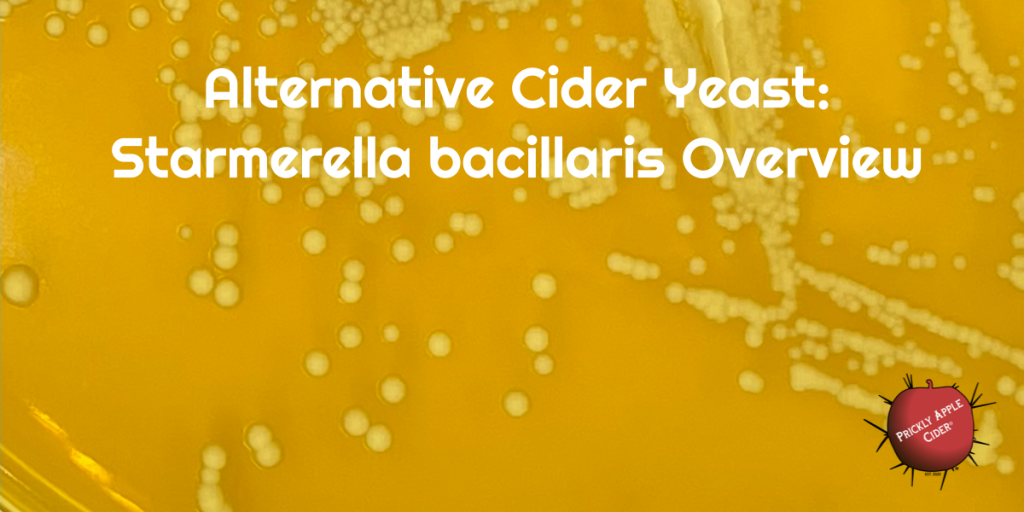I obtained 11 samples of non-Saccharomyces yeast from the USDA and have been conducting trials for my hard cider batches. Three of those strains where Pichia kluyveri. If you haven’t read it, I would encourage you to review my overview of Pichia kluyveri and the other strains. Just search non-Saccharomyces on the site or look for a link to the articles below. For a quick overview, Pichia kluyveri is a very common yeast that is naturally found on apples and fruit. Compared to Saccharomyces cerevisiae strains, it is a slower fermenter and is known to produce higher levels of polyols, like glycerol. It also tends to produce thiols that have tropical fruit aromas. The strains I tested had tropical fruit aromas but even more distinct was the banana aroma that each strain created. Let’s first review the approach I took for this trial and then review the results.
I used a blend of early apples and pears (60% Sweetie, 30% Akane, and 10% Hoshi Asian Pear) making three 1-gallon fermenters. The juice was treated with pectic enzyme and racked off after clarifying. I included 75 grams of the Sweetie apple peels in each fermenter. The Pichia kluyveri yeasts (y-17774, Y-11519, and Y-17228) were added after having propagated them using my standard method. The specific gravity started at 1.049 for this mixture and I monitored the ferments using my Tilt Hydrometers.
The ferment was slower than most Saccharomyces strains that I have used with mild fermentation activity through day 7. Fermentation became more vigorous at day 8 and lasted for 2 more days. All three strains had finished at 1.000 when I racked them at day 14 and moved them to storage. The temperature was in the 74-76F (23-24C) range for the ferment. Most commercial strains of Saccharomyces yeast I use finish in 4-7 days when I ferment in similar conditions. Most ciders improve with some aging but, I like to sample mine when racking to get a feel for how they fermented and how they could develop. Sometimes, the ones that I like least straight from fermentation become the ones I like best with some aging. However, after aging for 4 months, I judged the Y-17228 strain my favorite. I call this yeast “Tropical Breeze” given the fruity and tropical aromas it creates, especially banana. It will be interesting to see if this changes with additional aging. I also harvested these strains and begun reusing some for further trials.
| Strain ID | Ferment Days | Final Gravity | Clarity | Aroma | Taste |
| Y-17774 | 10 | 1.000 | Hazy | Banana | Banana & Sour |
| Y-11519 | 10 | 1.000 | Clear | Sulfur & Sour | Sour |
| Y-17228 | 10 | 1.000 | Clearest | Tropical | Fruity |
Overall, I deemed this trial a success. While a little slower, the yeast fermented to completion and the aromas were positive compared to many commercial strains that I have tried. I really liked the tropical, banana, and fruity aromas the Pichia created. While I used Fermaid-O in the propagation of the yeast, I didn’t use any nutrients in the fermentation. This year, I will ferment some with Fermaid-O added to the fermentation. I also didn’t get any measurable residual sweetness but, I wasn’t expecting it given my lower starting gravity. Some of the other non-Saccharomyces strains did finish with measurable residual sweetness, especially when I started with a higher sugar level. For now, I will be conducting additional tests with the Y-17228 strain. I am working on a cider yeast trail pack if you are interested in exploring some of these non-Saccharomyces yeast strains with me. Check The Shop & Recommended Products Page for available options or use the below button to jump to the Cider Yeast page.
Did you enjoy this article? Don’t miss future posts from PricklyCider.com by following us today! PricklyCider.com is your source for all things cider.






Great trial! I’m excited to see the progress into non saccharomyces strains in cider!
I’m curious as to how you are able to confirm if you had a culture domination with your propegated strains (I.e had you pasteurised first)?
And when adding pectic enyzym are you carrying out a full keeving operation or are you just clarifying and breaking down pectins in the juice?
LikeLike
Thanks for reading and the questions. For the first round, I didn’t use sterile juice on purpose so I don’t know for certain if it dominated. But, I monitored it closely, Given the speed at which it started, the time it took, and the aroma profile, I felt pretty confident that it had a significant impact if it didn’t dominate. I harvested and pitch some again to see how they fermented and I have monitored the yeast when making new starters to see if looked similar to how it looked when propagating. Pichia kluyveri for example creates a unique blooming form that both sits on the bottom and floats at the top. I have continued to see that characteristic. I have a new batch of strains that I am using now but I am thinking of doing some trials with sterile juice to see how it ferments. I use sterile juice for my propagation so I do see how it performs on a very small scale. Other strains like Lachancea show the souring characteristic they are known for so again, it appears to at least dominate at some level. Hanseniaspora uvarum tended to leave residual sweetness and along with other characteristics told me that all the yeasts I trialed appear to dominate the fermentation (at least in key characteristics) but everything is anecdotal.
I use pectic enzyme to clarify/break down pectin. Clearer juice tends to produce fruitier ciders and my experiments have shown that people liked my ciders better when clarified before fermenting.
LikeLike